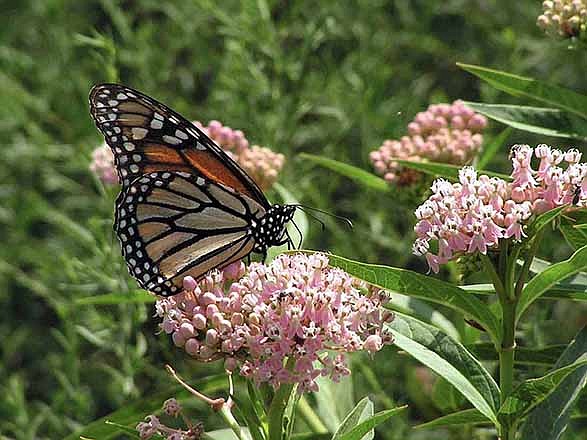Today is Earth Day. It's a day to recognize the value of the planet's resources and conserving them for the next generation.
The monarch butterfly, while not a utilitarian resource, is one of earth's beauties that may not be around for future generations, experts say.
This year's population, which should arrive in the next few weeks from its winter home in Mexico, is estimated at 33 million, according to Jaime Pinero, Lincoln University extension specialist in integrated pest management. Compare that to the peak migration of 1 billion in 1966, he said.
"The monarchs need your help," Pinero said.
Locally, several efforts have been made in recent years to benefit the monarchs while they're in Mid-Missouri during the spring and summer.
The Missouri Prairie Foundation manages more than 3,000 acres of land across the state, with unplowed prairies, the original habitat for monarchs and other creatures. The River Bluffs Audubon Society installed the Dorothy Bushman Butterfly Garden along the Edgewood Drive Greenway in 2004 in collaboration with the Jefferson City Parks, Recreation and Forestry Department.
In the last few years, LU has been building a native plants garden with butterflies in mind. It will soon include a butterfly house. And last year, a butterfly garden was planted at Moreau Heights Elementary School.
Several naturalized areas, like the Runge Nature Center, also provide butterfly-friendly plantings.
What professionals like Pinero and Nadia Navarrete-Tindall, extension specialist in native plants, hope for is a broader consideration for the fading ecosystem. From 1999 to 2010, the amount of milkweed in the Midwest landscape declined by 58 percent.
One of the challenges is overcoming a concept of perfection. Garden clubs and individual gardeners have noticed the need for native plants that benefit native insects, birds and wildlife, Navarrete-Tindall said.
At the Lincoln University Farmers Market, which opened Saturday and will continue 9 a.m.-noon Saturdays through Oct. 3, many shoppers were asking for butterfly milkweed, she said.
Gardeners may not know there is a variety of milkweeds that serve the same purpose as host plant and food source for the monarch butterfly, she said.
For example, honey vine is in the milkweed family and likely may be growing in untouched areas of farms and woods.
"It's not as showy like other milkweeds, but it is fragrant," Navarrete-Tindall said.
If property owners would learn to identify these beneficial plants, they could leave them instead of cutting them down or using permanent weed-killing chemicals, Pinero said.
Missouri has 11 species in the genus Asclepias, the only thing the monarch larvae eat, said Carol Davit, foundation executive director.
The common milkweed is the best source for the monarch. But it is aggressive and not as showy as others. At Lincoln, a patch has been planted in a less prominent location, leaving the prettier plants for the major native plant beds.
Then, there's the purple milkweed, adapted to shade, or the four-leaf milkweed, an early spring bloomer.
"If we're going to protect the monarch, we're going to do it with native plants," Navarrete-Tindall said.
In addition to helping the monarch, the butterfly helps pollinate fruits and vegetables.
Farmers also can make a difference by using broad spectrum herbicides sparingly, Pinero said.
The monarch also faces other threats, such as disease, frost and distracting plantings in Florida, which prevent them from returning to Mexico in time, Pinero said.
The orange and black wings may be seen in the next few weeks. But it's the time when they leave in flutters that presents the best viewing. In the meantime, they can be seen around milkweed plants and other flowering food sources, including goldenrod or asters in the fall.
Navarrete-Tindal, encourages people to gain appreciation for the caterpillars, too. Even the monarch's cocoon is a pretty green with gold dots, she said.
Spring is the time to plant shrubs, trees and wildflowers to attract and support all the varieties of butterflies in Missouri.
Last year, the foundation was able to give away more than 4,000 milkweed and nectar plants beneficial to monarchs through a grant from the Missouri Department of Conservation. It hopes to repeat that in the future.
Other local nurseries and farmers markets likely will have butterfly-friendly plantings.
Earth Day Celebration Friday
Earth Day will be celebrated 10 a.m.-2 p.m. Friday at the state Capitol.
The Missouri Department of Natural Resources will host the annual event targeted at fifth-grade students, but open to all ages.
More than 1,200 students and sponsors are expected to attend the educational exhibits, interactive displays and stage shows, and live bird presentations by the World Bird Sanctuary.
Check www.dnr.mo.gov/earthday for more information.

